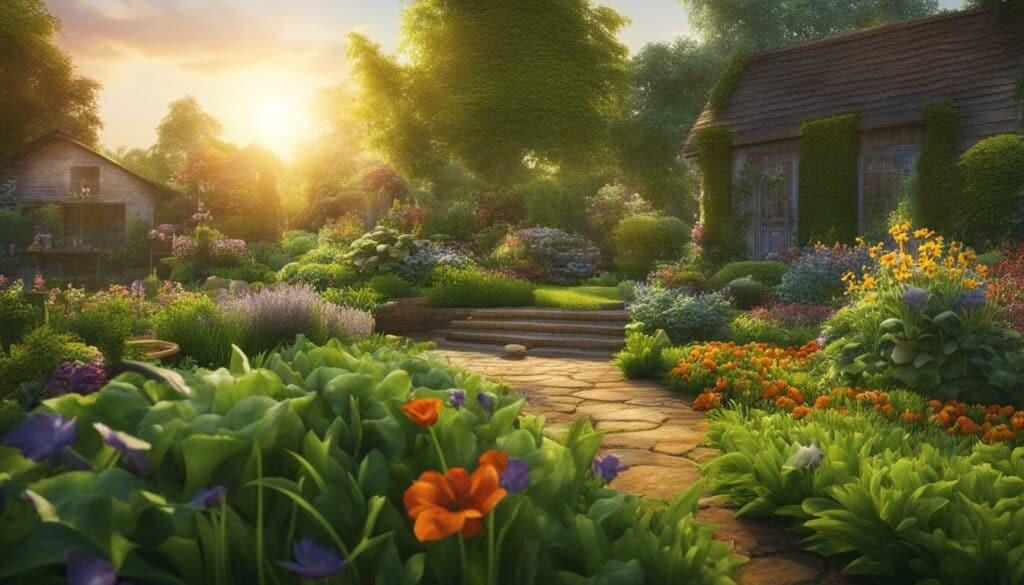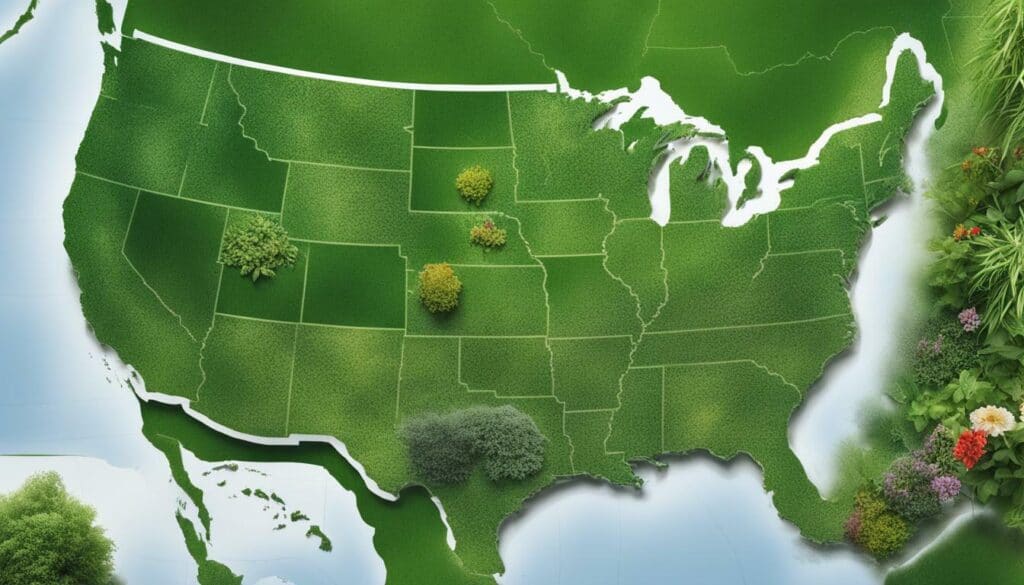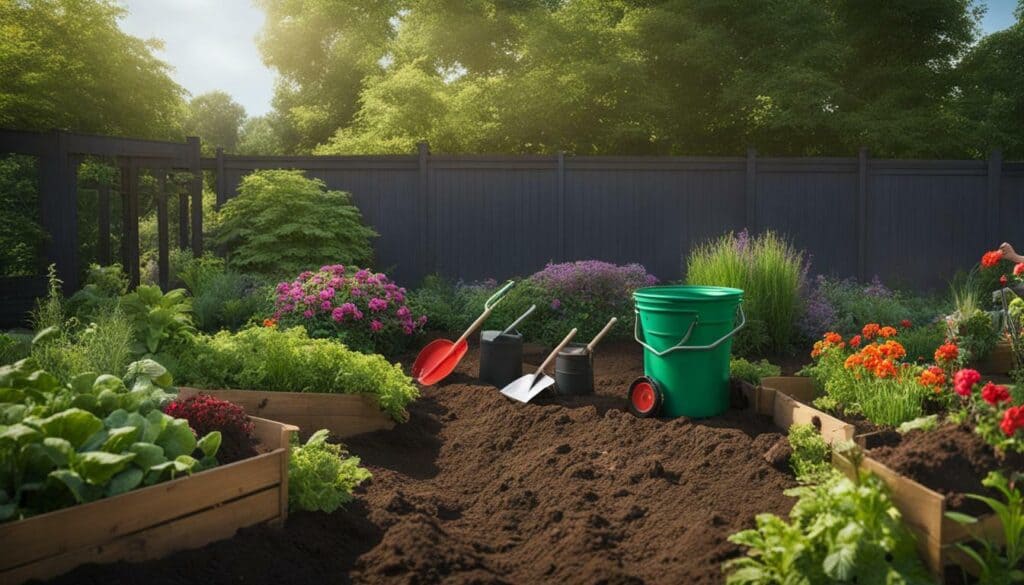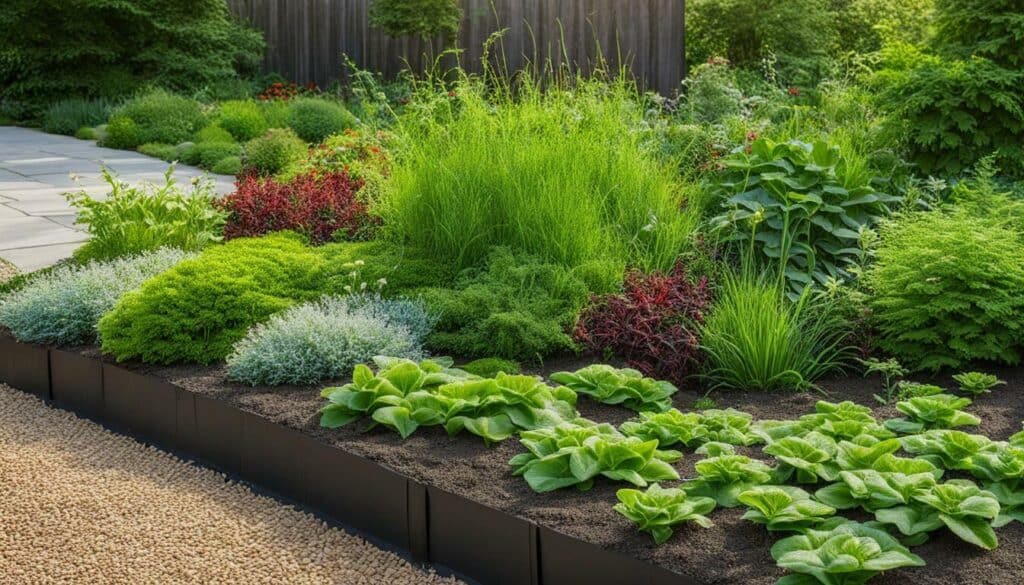Are you ready to transform your lawn and garden into a flourishing oasis? With my top lawn and garden care tips, you’ll soon be on your way to becoming a master gardener. Whether you’re a beginner or an experienced gardener, these expert tips will help you achieve a healthy and thriving green space.
- Remove excessive thatch to maintain a healthy lawn and garden.
- Proper watering techniques are essential for vibrant green spaces.
- Fertilize your grass with slow-release options or “weed and feed” products for optimal nourishment.
- Test your soil’s pH and adjust it if necessary.
- Follow region-specific fertilizer schedules for best results.
Understanding the Importance of Thatch Removal
To achieve lush greenery, it’s essential to start with a solid foundation. That’s why understanding the importance of thatch removal is the first step towards a thriving lawn and garden. Thatch refers to the layer of dead grass and organic debris that accumulates on the soil surface, preventing water, air, and nutrients from reaching the roots of your plants.
This layer of thatch can become excessive over time, causing several issues, including reduced water absorption, increased disease and pest susceptibility, and poor nutrient uptake. Therefore, regular dethatching is crucial for maintaining a healthy and vibrant green space.
There are various methods to effectively remove thatch from your lawn and garden. To get rid of excessive thatch, you can use a thatching rake or a power dethatcher. These tools help break up the compacted layer and remove the debris, allowing your lawn to breathe and absorb the necessary nutrients.
The Benefits of Thatch Removal
Dethatching your lawn and garden offers several benefits. Firstly, it improves water infiltration, ensuring that rainwater and irrigation can penetrate the soil and reach the roots more effectively. This helps to prevent waterlogging and reduces the risk of fungal diseases.
Secondly, removing thatch promotes healthier root growth by enhancing the availability of oxygen and nutrients in the soil. This results in stronger, more resilient plants that are better equipped to withstand environmental stresses.
Lastly, dethatching improves the overall appearance of your lawn and garden. By eliminating the layer of dead debris, your green spaces will look more vibrant and rejuvenated, providing a welcoming and aesthetically pleasing environment.
| Key Benefits of Thatch Removal: |
|---|
| Improved water absorption |
| Enhanced root growth |
| Enhanced nutrient uptake |
| Reduced risk of diseases |
| Improved overall appearance |
“Dethatching your lawn and garden is like giving your plants a breath of fresh air. It improves their health and vitality, ensuring they thrive in a well-nourished environment.” – [Your Name]
Watering Strategies for a Vibrant Lawn
Keeping your lawn hydrated is crucial for its overall health, and in this section, I’ll share my strategies for achieving optimal watering. By following these effective lawn maintenance tips, you’ll ensure that your grass remains lush and vibrant throughout the year.
Firstly, it’s important to understand that different climates require different watering techniques. If you live in a hot and dry region, you may need to water your lawn more frequently to compensate for the lack of natural rainfall. Conversely, if you reside in a cooler and more humid area, you may be able to water less frequently. It’s essential to find the right balance and adjust your watering schedule accordingly.
One effective way to ensure your lawn receives sufficient water is by using an irrigation system. These systems can be set on timers to water your lawn at specific intervals, taking into account the climate and the needs of your grass. This method saves time and ensures consistent watering, even when you’re away from home. Consider installing a smart sprinkler system that can monitor weather conditions and adjust watering schedules automatically.
Additionally, it’s crucial to water your lawn deeply and infrequently. This helps promote deep root growth, making your grass more resistant to drought and stress. Aim for approximately one inch of water per week, either through rainfall or irrigation. By watering deeply, you encourage your grass to develop a strong and healthy root system, resulting in a lush and vibrant lawn.

Remember, overwatering can be just as damaging to your lawn as underwatering. Excessive water can lead to shallow root growth, increased vulnerability to diseases, and the development of thatch. To avoid these issues, always monitor the moisture level of your soil before watering. One way to check is by inserting a screwdriver into the ground. If it goes in easily and is moist, your lawn doesn’t need watering yet. If it’s dry, it’s time to water.
Summary:
- Water your lawn according to your region’s climate and adjust your watering schedule accordingly.
- Consider using an irrigation system, such as a smart sprinkler system, for efficient and consistent watering.
- Water deeply and infrequently to promote deep root growth and a healthy lawn.
- Avoid overwatering by monitoring the moisture level of your soil before watering.
| Benefits of Effective Watering Strategies: |
|---|
| Promotes deep root growth |
| Makes your grass more resistant to drought and stress |
| Prevents shallow root growth and thatch development |
| Conserves water and prevents wastage |
The Art of Fertilizing Your Grass
Achieving a lush green lawn is not just about watering and maintenance; it also involves mastering the art of fertilizing. Fertilizers provide essential nutrients that grass needs to grow strong and healthy. However, not all fertilizers are created equal. It’s important to understand the different types available and how to use them effectively.
When it comes to fertilizing your grass, slow-release fertilizers are a great option. These fertilizers gradually release nutrients over time, ensuring a steady supply for your lawn. This not only promotes healthier growth but also reduces the risk of over-fertilizing and burning your grass. Look for slow-release fertilizers that contain a balanced blend of nitrogen, phosphorus, and potassium, commonly referred to as NPK.
“Weed and feed” products are another popular choice for fertilizing your lawn. These products not only provide nutrients but also help control weeds. They contain herbicides that target common lawn weeds, such as dandelions and crabgrass. By applying a “weed and feed” fertilizer, you can save time and effort by feeding your grass while simultaneously tackling weed problems.

To ensure you’re using the right type and amount of fertilizer, it’s crucial to follow a fertilizer schedule specific to your region and grass type. This schedule will take into account factors such as climate, soil conditions, and the specific nutrient requirements of your grass. By following a recommended fertilizer schedule, you can optimize the health and appearance of your lawn.
| Fertilizer Application Schedule | Grass Type | Region |
|---|---|---|
| Early Spring | Kentucky Bluegrass, Fescue | North and Northeast |
| Spring | Bermuda Grass, St. Augustine Grass | South |
| Early Summer | Zoysia Grass | Southeast |
| Late Summer | Buffalo Grass, Centipede Grass | Midwest and Southwest |
| Fall | Rye Grass, Bentgrass | All Regions |
Remember, fertilizing your grass is just one part of the equation. To maximize the benefits of fertilization, it’s important to follow a comprehensive lawn care routine that includes proper watering, mowing, and weed control. By combining these practices, you can create a thriving and vibrant green space that enhances the beauty of your home.
Testing and Adjusting Soil pH
Your lawn and garden’s pH level can make or break their overall health. Let’s explore how you can ensure your soil pH is just right. Testing your soil’s pH is an essential step in understanding its properties and its suitability for different plants. You can easily test the pH level using a soil testing kit available at your local garden center or online. Simply follow the instructions provided in the kit to obtain accurate results.
The ideal pH level for most lawns and gardens is slightly acidic to neutral, between 6.0 and 7.0. If your soil’s pH is too high or too low, it can hinder nutrient availability and nutrient absorption by plants. To adjust the pH level, you can add certain amendments to your soil.
If your soil is too acidic (pH below 6.0), you can raise the pH by adding lime. Lime helps neutralize the acidity and brings the pH level back to the desired range. On the other hand, if your soil is too alkaline (pH above 7.0), you can lower the pH by adding elemental sulfur or other acidifying agents. It’s important to follow the instructions and recommendations on the product packaging to ensure proper application and avoid overcorrection.
| pH Level | Soil Condition | Adjustment Required |
|---|---|---|
| Below 6.0 | Too acidic | Add lime to raise pH |
| 6.0 – 7.0 | Ideal range | No adjustment required |
| Above 7.0 | Too alkaline | Add sulfur or acidifying agents to lower pH |
Remember:
- Regularly testing your soil’s pH is crucial to maintaining a healthy lawn and garden.
- Adjusting the pH level will help optimize nutrient availability for plants.
- Always follow the instructions and recommendations provided by the soil testing kit and amendment products.

By monitoring and adjusting your soil’s pH, you’ll create an ideal growing environment for your plants, ensuring their overall health and vitality. Take the time to test your soil and make any necessary adjustments, and you’ll be rewarded with a thriving lawn and garden.
Fertilizer Schedules and Regional Considerations
Fertilizing your lawn and garden requires careful consideration of your regional factors and grass type. Let’s dive into how to tailor your fertilizer schedule accordingly.
When it comes to fertilizing, it’s crucial to understand the specific needs of your region’s climate and the type of grass you have. Different grasses thrive in different conditions, so selecting the right fertilizer and applying it at the appropriate times can make a significant difference in the health and appearance of your lawn and garden.
One key factor to consider is the timing of fertilization. Typically, it’s recommended to apply fertilizer in the early spring and fall when the grass is actively growing. However, the exact timing may vary depending on your region. Some regions have longer growing seasons, while others experience colder winters, which may require adjustments to your fertilizer schedule.
Additionally, different types of grass have varying nutrient requirements. For example, cool-season grasses like Kentucky bluegrass and fescue usually benefit from a spring and fall application of slow-release nitrogen fertilizers. Warm-season grasses like Bermuda grass and St. Augustine grass, on the other hand, may require more frequent fertilization during their active growing season.
| Region | Grass Type | Fertilizer Schedule |
|---|---|---|
| Northeast | Kentucky bluegrass, fescue | Early spring, fall |
| Southeast | Bermuda grass, St. Augustine grass | Throughout active growing season |
| Midwest | Perennial ryegrass, Kentucky bluegrass | Spring, fall |
| Southwest | Zoysia grass, Bermuda grass | Spring, summer |
Remember to always follow the instructions on the fertilizer packaging and use a spreader to ensure even application. Over-fertilizing can harm your grass and contribute to environmental pollution, so be mindful of the recommended rates and avoid excessive use.
By understanding the fertilizer needs of your region and grass type, you can develop a tailored fertilizer schedule that promotes healthy growth and maintains a vibrant lawn and garden all year round.

- “Lawn Fertilization: A Basic Guide for Homeowners.” University of Maryland Extension, 2021.
- “Fertilizing Your Lawn.” University of Florida IFAS Extension, 2021.
- “Lawn Fertilization.” Penn State Extension, 2021.
Harnessing the Power of Compost and Homemade Mulch
Nature has given us powerful tools to enrich our green spaces, and in this section, we’ll explore the wonders of compost and homemade mulch. Compost is a nutrient-rich organic matter that can enhance soil fertility, improve moisture retention, and promote healthy plant growth. By recycling kitchen scraps, yard waste, and other organic materials, we can create our own compost to nourish our gardens.

Compost is often referred to as “black gold” due to its incredible benefits for soil health.
To make your own compost, start by collecting organic materials such as fruit and vegetable peels, coffee grounds, eggshells, and leaves. Avoid using meat, dairy products, and oily substances, as they may attract pests or create unpleasant odors. Mix these materials with yard waste like grass clippings, small branches, and dried leaves. Turn the pile regularly to provide oxygen and promote decomposition. Over time, these organic ingredients will break down, creating nutrient-rich compost that can be added to your soil or used as a top dressing around plants.
Homemade mulch is another valuable resource for gardeners. It acts as a natural weed barrier, preventing weed growth by blocking sunlight and reducing weed germination. Mulch also helps retain soil moisture, keeping your plants hydrated and reducing the need for frequent watering. Additionally, it regulates soil temperature, protecting plant roots from extreme heat or cold.
Types of Homemade Mulch
There are various types of materials that can be used as homemade mulch:
- Grass clippings: Spread a thin layer of dried grass clippings around your plants to suppress weeds and add nutrients to the soil.
- Leaves: Shred fallen leaves and spread them around your garden beds or use them as a protective layer for potted plants.
- Straw: Straw is an excellent mulching material, especially for vegetable gardens, as it helps retain moisture and keeps the soil temperature stable.
- Wood chips: Use wood chips as mulch around trees and shrubs, ensuring they are not directly in contact with the plant’s trunk to prevent rot.
By harnessing the power of compost and homemade mulch, you can create a thriving and sustainable garden. These natural resources will not only improve the health of your plants but also reduce waste and minimize the need for synthetic fertilizers and pesticides. So, start composting and mulching today and watch your green spaces flourish!
| Type of Homemade Mulch | Benefits |
|---|---|
| Grass clippings | Suppresses weeds, adds nutrients to the soil |
| Leaves | Protects garden beds, retains soil moisture |
| Straw | Retains moisture, stabilizes soil temperature |
| Wood chips | Protects trees and shrubs, prevents soil erosion |
Effective Weed Control Strategies
Don’t let weeds take over your beautiful green spaces! In this section, we will explore effective strategies to keep those unwanted plants at bay. Weeds can quickly spread and choke out your desired plants, so it’s crucial to stay proactive in your weed control efforts.
An important step in weed control is to remove weeds early and consistently. Regularly inspect your lawn and garden for any signs of weed growth and promptly remove them. This prevents weeds from establishing deep root systems and spreading their seeds.
Additionally, consider employing creative methods to deter animals from damaging your garden. You can tie rattling pie plates near the garden to scare away birds and other small animals. Fencing can also provide protection against larger animals, such as deer, that may be attracted to your plants.
With the right strategies and consistent effort, you can keep weeds at bay and maintain a clean and thriving lawn and garden. Remember to stay vigilant and implement these expert gardening tips for proven garden care.

Embrace the wonders of technology to enhance your gardening experience. Let’s explore how innovative tools can make your lawn and garden care more efficient and enjoyable.
One of the key advancements in gardening technology is the introduction of Wi-Fi-enabled gardening systems. These systems allow you to monitor and control your lawn and garden from anywhere using a smartphone or computer. With just a few taps on your device, you can adjust watering schedules, monitor soil moisture levels, and even receive notifications when it’s time to fertilize or dethatch. This level of convenience ensures that your green spaces receive the care they need, even when you’re busy or away from home.
Another groundbreaking tool is the smart sprinkler system. These systems utilize weather data and moisture sensors to deliver the optimal amount of water to your lawn. By automatically adjusting watering schedules based on rainfall and evaporation rates, smart sprinklers help conserve water and prevent over or under watering. Some smart sprinkler systems also have advanced features like zoning, which allows you to water different areas of your lawn independently based on their specific needs. This precision watering not only conserves resources but also promotes healthier and more resilient grass growth.

Aside from automated systems, there are also innovative gardening tools that can simplify your lawn and garden care routine. For example, there are robotic mowers that can autonomously trim your lawn, saving you time and effort. These mowers are equipped with sensors to navigate obstacles and adjust cutting patterns, ensuring an even and well-manicured lawn. Additionally, there are smart garden sensors that monitor environmental conditions such as light levels, humidity, and temperature. By providing real-time data, these sensors help you make informed decisions about plant placement and care.
In conclusion, technology has revolutionized the way we approach gardening. Wi-Fi-enabled gardening systems, smart sprinkler systems, robotic mowers, and smart garden sensors all contribute to making lawn and garden care more efficient and enjoyable. By embracing these advancements, you can unlock the full potential of your green spaces and achieve a thriving and beautiful garden with less effort and greater precision.
Conclusion on Lawn and Garden Care Tips
By following these expert lawn and garden care tips, you’ll unlock your green thumbs and transform your outdoor spaces into thriving oases. Happy gardening!
To achieve a healthy and vibrant lawn, it’s crucial to address key aspects of lawn care. Start by checking for excessive thatch and removing it through dethatching. Thatch can hinder the growth of your grass and affect its overall health. Once thatch is taken care of, water your lawn wisely, considering your region’s climate and utilizing irrigation systems if necessary. Adequate watering is essential for maintaining a lush and vibrant lawn.
Proper fertilization is also vital for the well-being of your grass. Choose the right type of fertilizer, such as slow-release options, to provide your lawn with the necessary nutrients. Consider using “weed and feed” products to simultaneously feed your grass and control weed growth. Additionally, testing your soil’s pH and adjusting it if necessary will optimize your lawn’s health.
Don’t forget to follow a fertilizer schedule that is recommended for your specific region and grass type. Different areas and grass varieties have varying needs, so it’s important to tailor your fertilizer application accordingly. Lastly, harness the power of compost and homemade mulch to enhance soil fertility, retain moisture, and suppress weed growth. These natural methods can greatly contribute to the health and longevity of your lawn and garden.
For effective weed control, it’s essential to weed early and consistently. Remove weeds as soon as they appear to prevent them from spreading and taking over your green spaces. To protect your garden from animals, consider tying rattling pie plates or using fencing to create a deterrent. These creative methods can help safeguard your hard work and keep your garden thriving.
Embracing technology can also make your gardening tasks more efficient. Explore innovative tools like Wi-Fi-enabled gardening systems and smart sprinkler systems, which can automate certain aspects of your lawn and garden care routine. These tools can save you time and effort, allowing you to enjoy your green spaces to the fullest.
By adopting these expert lawn and garden care tips, you’ll create a healthy and vibrant outdoor environment that you can be proud of. So get out there, put your green thumbs to work, and watch your lawn and garden flourish!
FAQ on Lawn and Garden Care Tips
Q: What is thatch and why is it important to remove it?
A: Thatch is the layer of dead grass and organic debris that accumulates on the soil surface. It is important to remove excessive thatch as it can prevent water, nutrients, and air from reaching the roots of your grass, leading to a weak and unhealthy lawn.
Q: How often should I water my lawn?
A: The frequency of watering depends on your region’s climate. As a general rule, it is better to water deeply and infrequently rather than shallowly and frequently. Aim to give your lawn about 1 inch of water per week, either through rainfall or irrigation.
Q: What type of fertilizer should I use for my grass?
A: The type of fertilizer you should use depends on your lawn’s specific needs. Slow-release fertilizers are a great option as they provide a steady supply of nutrients over time. Additionally, “weed and feed” fertilizers can be used to simultaneously feed your grass and control weed growth.
Q: How do I test my soil’s pH?
A: You can test your soil’s pH using a soil testing kit or by sending a soil sample to a laboratory for analysis. pH levels below 7 are acidic, while levels above 7 are alkaline. Adjusting the pH may be necessary to optimize nutrient uptake by your plants.
Q: Are there specific fertilizer schedules for different regions?
A: Yes, different regions and grass types have varying fertilizer needs. It is important to follow a fertilizer schedule recommended for your specific region and grass type to ensure optimal growth and health.
Q: How can compost and homemade mulch benefit my lawn and garden?
A: Compost and homemade mulch are excellent natural ways to enhance soil fertility and moisture retention. They also act as a barrier, blocking weed growth and reducing the need for chemical weed control. By incorporating compost and mulch into your lawn and garden care routine, you can improve plant health and conserve water.
Q: What are some effective weed control strategies?
A: To effectively control weeds, it is important to regularly remove them as soon as they appear. This can be done manually or with the help of gardening tools. Additionally, you can use creative methods such as tying rattling pie plates or using fencing to deter animals from damaging your garden.
Q: How can technology help with gardening?
A: Technology offers innovative tools that can make gardening more efficient. Wi-Fi-enabled gardening systems allow you to monitor and control your garden remotely, while smart sprinkler systems help conserve water by adjusting watering schedules based on weather conditions. Embracing technology can simplify your lawn and garden care routine.
What Are Some Effective Landscaping Repair Tips for Maintaining a Green Thumb?
Maintaining a green thumb requires diligent care and attention. Here are a few landscaping repair tips to help you preserve your prized garden. First, regularly inspect your plants for signs of disease or pests, ensuring prompt treatments. Second, address any drainage issues by redirecting water or improving soil quality. Finally, regularly prune and trim to prevent overgrowth and maintain a tidy appearance. These landscaping repair tips will ensure a flourishing and visually appealing garden.





Leave a Reply